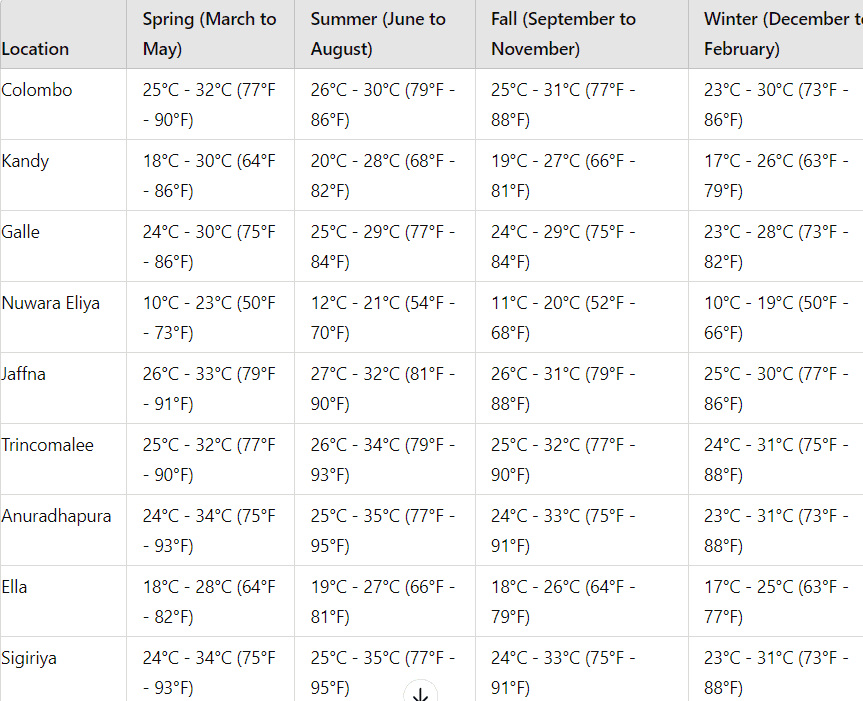Before Your Trip to Sri Lanka
The Weather in Sri Lanka
Sri Lanka has a tropical climate characterized by distinct wet and dry seasons influenced by two monsoon periods. The southwest monsoon, from May to September, brings heavy rain to the southwest and western regions, including Colombo and Galle. Conversely, the northeast monsoon, from December to February, affects the northeast and eastern parts, such as Trincomalee and Batticaloa. The central highlands, including Kandy and Nuwara Eliya, experience cooler temperatures year-round due to higher elevations.
The dry season varies across the island. The southwest, including popular tourist destinations like Bentota and Mirissa, enjoys dry weather from December to March, making it an ideal time to visit. Meanwhile, the eastern and northern regions, such as Arugam Bay and Jaffna, experience their dry season from May to September. Overall, Sri Lanka’s diverse climate requires careful planning based on the specific region and time of year you plan to visit.

How to Dress in Sri Lanka – Seasonal Considerations
Dressing appropriately for the weather in Sri Lanka ensures comfort and respect for local customs. With its tropical climate, understanding the seasonal variations will help you pack the right clothing for your trip or daily life. Here are some tips for dressing in Sri Lanka across the four seasons:
Spring (March to May)
Spring in Sri Lanka is warm and humid, particularly in the lowland and coastal areas. Lightweight, breathable fabrics such as cotton and linen are ideal. Loose-fitting clothes like T-shirts, shorts, and dresses are recommended. A hat or cap and sunglasses will protect you from the sun, while a light raincoat or umbrella is useful for sudden showers.
Summer (June to August)
Summer coincides with the southwest monsoon, bringing heavy rains to the western and southern regions. Waterproof clothing, including rain jackets and quick-dry fabrics, is essential. In the drier northern and eastern areas, light, airy clothing is suitable. Ensure you have comfortable footwear for exploring, as roads can be muddy during the rains.
Autumn (September to November)
Autumn is marked by inter-monsoonal activity, leading to unpredictable weather with both rain and sunshine. Layering is key during this season. Pack light shirts, trousers, and a mix of short-sleeve and long-sleeve options. A lightweight waterproof jacket or poncho will help you stay dry during sudden downpours.
Winter (December to February)
Winter is the dry season for the southwest and southern regions, making it the best time to visit popular beaches. Light, comfortable clothing such as shorts, T-shirts, and swimwear is ideal. In the central highlands, pack warmer clothes like sweaters and jackets, as temperatures can drop significantly in the evenings.
The Currency in Sri Lanka

The currency in Sri Lanka is the Sri Lankan Rupee (LKR), abbreviated as Rs. Banknotes come in denominations of Rs. 20, Rs. 50, Rs. 100, Rs. 500, Rs. 1000, Rs. 2000, and Rs. 5000, while coins are available in values of Rs. 1, Rs. 2, Rs. 5, and Rs. 10. Credit and debit cards are widely accepted in urban areas and tourist destinations, but cash is still commonly used, especially in rural regions and for small purchases. ATMs are plentiful and offer competitive exchange rates, making them a convenient option for obtaining rupees during your stay in Sri Lanka.
Where to Exchange Money in Sri Lanka?
Exchanging money in Sri Lanka can be done at various locations, including banks, exchange bureaus, and post offices. Banks generally offer competitive rates and are reliable options for currency exchange. Exchange bureaus, especially those found in tourist areas, are convenient but may have higher fees. Airports and major train stations also provide currency exchange services, although rates might not be as favorable. ATMs are widely available throughout Sri Lanka and often offer good exchange rates, allowing you to withdraw rupees directly using your debit or credit card.
Tips for Exchanging Money in Sri Lanka
When exchanging money in Sri Lanka, it’s important to compare rates and fees to get the best deal. Using ATMs is often the most convenient and cost-effective option, but check with your bank regarding foreign transaction fees. Avoid exchanging large sums at airports or tourist hotspots, where rates may be less favorable. Instead, use banks or reputable exchange bureaus. Carry small denominations for ease of transactions, and always verify the exchange rate and any associated fees before completing a transaction. Keeping a mix of cash and card options ensures you’re prepared for various situations.
The Language in Sri Lanka
Sri Lanka is a multilingual country with Sinhala and Tamil as its official languages. Sinhala is predominantly spoken in the southern, western, and central regions, while Tamil is widely used in the northern and eastern parts of the island. English is also commonly spoken and understood, especially in urban areas, tourist destinations, and among the younger population. It is often used for official and business purposes and is taught in schools across the country.
In rural areas and smaller towns, English may not be as commonly spoken, so learning a few basic phrases in Sinhala or Tamil can be very helpful. For example, “Ayubowan” (hello) in Sinhala and “Vanakkam” (hello) in Tamil can enhance your interactions. Major cities like Colombo, Kandy, and Galle have a higher rate of English proficiency due to their cosmopolitan nature and significant expatriate communities. Overall, while English is widely understood in many parts of Sri Lanka, being aware of regional languages and customs will enrich your travel experience.
The Necessary Documents and Emergency Contacts
Traveling to Sri Lanka requires proper documentation and awareness of emergency contacts to ensure a smooth trip. Essential documents include a valid passport, and for many non-Sri Lankan travelers, a visa. It’s crucial to check the specific entry requirements based on your nationality. Additionally, carrying copies of your passport, visa, and travel insurance can be helpful in case of emergencies. Familiarize yourself with local emergency numbers and embassy contact information before you travel.
Visa and Passport
To enter Sri Lanka, you need a valid passport with at least six months of validity beyond your planned departure date. Most travelers require a visa, which can be obtained online through the Electronic Travel Authorization (ETA) system for short stays or at a Sri Lankan consulate for longer visits. Ensure you have all necessary documents, including proof of accommodation, return tickets, and sufficient funds for your stay. Check the Sri Lankan consulate or embassy in your home country for specific visa requirements and application procedures.
Travel Insurance
You must have travel insurance with a minimum medical, evacuation and repatriation coverage of US$50,000 covering all applicable dates of travel with the Tour Operator. This insurance must cover personal injury and emergency medical expenses. On the first day of each Tour, a representative of the Tour Operator will verify that you have sufficient insurance in place. You are strongly recommended to extend your coverage to include cancellation, curtailment, and all other expenses that may arise as a result of loss, damage, injury, delay or inconvenience while traveling. You acknowledge that insurance coverage is not included in the cost of any Tour offered by the Tour Operator, and you are required to obtain separate coverage at an additional cost. It is your responsibility to ensure that you have sufficient coverage and comply with the terms of the applicable insurance plans. You are responsible for advising your insurer of the type of travel, destination(s) and activities included in your booking so that the insurer may provide appropriate coverage.
Travel Vaccines for Sri Lanka
While no specific vaccinations are required to enter Sri Lanka, it’s recommended to be up-to-date on routine vaccines such as measles, mumps, rubella (MMR), diphtheria, tetanus, and pertussis (DTP), varicella (chickenpox), polio, and your yearly flu shot. Depending on your travel plans and health status, additional vaccines such as hepatitis A, hepatitis B, typhoid, and rabies might be advised. Consult with a healthcare provider at least six weeks before your trip to discuss any health concerns and receive appropriate vaccinations.
Essential Emergency Numbers in Sri Lanka
In case of emergencies while in Sri Lanka, it’s important to know the essential emergency numbers. Dial 119 for police assistance, 110 for medical emergencies, and 111 for fire services. Additionally, the Tourist Police can be reached at 1912 for assistance with travel-related issues. Keep these numbers handy and accessible during your stay in Sri Lanka to ensure prompt help in any emergency situation.
Vegetarian, Vegan and Gluten-free Eating in Sri Lanka

Sri Lanka is a paradise for vegetarians, with a rich culinary tradition that includes numerous vegetarian dishes. Many traditional Sri Lankan meals are plant-based, featuring rice, lentils, vegetables, and coconut. Dishes like dhal curry, jackfruit curry, and coconut sambol are widely available and delicious. Vegan options are also becoming more common, particularly in urban areas where awareness of plant-based diets is growing. Major cities like Colombo, Kandy, and Galle boast numerous vegetarian and vegan restaurants catering to different tastes and dietary needs.
Gluten-free eating in Sri Lanka can be a bit more challenging but is manageable with some planning. Traditional Sri Lankan cuisine includes many naturally gluten-free dishes made from rice, lentils, and coconut. However, wheat-based items like roti and some baked goods are common, so it’s important to ask about ingredients when dining out. Many upscale restaurants and health food stores in larger cities offer gluten-free options and products. Learning to communicate your dietary restrictions in Sinhala or Tamil can be helpful in ensuring your needs are understood and met. Overall, Sri Lanka’s diverse cuisine offers ample opportunities for vegetarians, vegans, and those with gluten intolerance to enjoy flavorful meals.
Do’s and Don’ts in Sri Lanka
Do’s
- Respect Religious Sites: Dress modestly and remove shoes and hats when visiting temples and other religious sites.
- Use Right Hand for Eating: It’s polite to use your right hand for eating and giving/receiving items.
- Greet with a Smile: A friendly greeting is appreciated, and a slight bow with clasped hands (Ayubowan) is a common gesture.
- Stay Hydrated: Drink bottled or purified water to avoid waterborne illnesses.
- Respect Elders: Show respect by addressing elders with appropriate titles.
Don’ts
- Avoid Public Displays of Affection: Public affection is generally frowned upon.
- Don’t Touch Heads: The head is considered sacred, especially in Buddhist traditions.
- Avoid Pointing Feet: Pointing feet at people or religious objects is considered disrespectful.
- Don’t Give Money to Beggars: Instead, donate to reputable charities.
- Avoid Discussing Politics or Religion: These topics can be sensitive and may lead to misunderstandings.
Wifi Access and Mobile Connectivity in Sri Lanka
Sri Lanka has good mobile connectivity, particularly in urban areas. Major cities and tourist destinations offer reliable 4G coverage. Public WiFi is available in many hotels, cafes, and airports, though speeds and security can vary. Buying a local SIM card from providers like Dialog, Mobitel, or Airtel is a convenient way to stay connected. Ensure your phone is unlocked before you travel. Prepaid plans are affordable and include data, calls, and text services. In rural areas, connectivity may be less reliable, so plan accordingly if traveling to remote regions.
Travel Adapter for Sri Lanka
In Sri Lanka, the standard voltage is 230V, and the frequency is 50Hz. The power plugs and sockets are of type D, M, and G. Type D has three round pins in a triangular pattern, type M has three round pins (larger than type D), and type G has three rectangular pins in a triangular pattern. Travelers from countries with different plug types will need a travel adapter. It’s also a good idea to carry a universal adapter with surge protection to safeguard your electronic devices.
In Your Suitcase
- Lightweight and breathable clothing suitable for warm to hot temperatures.
- Modest attire for visiting religious sites and conservative areas.
- Comfortable walking shoes or sandals.
- Sunscreen, hat, and sunglasses for sun protection.
- Insect repellent and anti-diarrheal medication.
- Travel adapter for Type C, D, and M plugs.
- Portable power bank for charging devices.
In Your Daypack
- Bottled water and reusable water bottle.
- Portable umbrella or rain jacket during monsoon season.
- Small first aid kit with basic medications.
- Snacks and energy bars for quick refreshment.
- Guidebook or map, or smartphone with offline maps.
- Hand sanitizer and tissues for hygiene.
- Camera or smartphone for capturing memorable moments.










